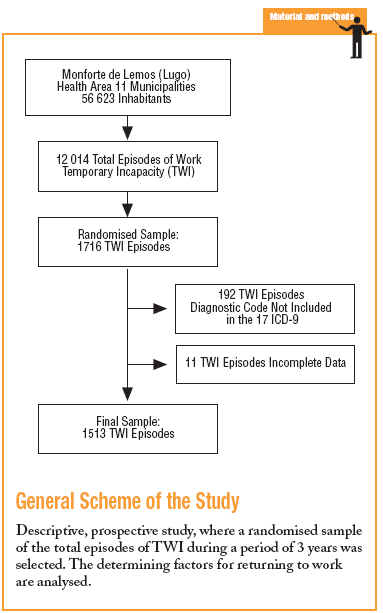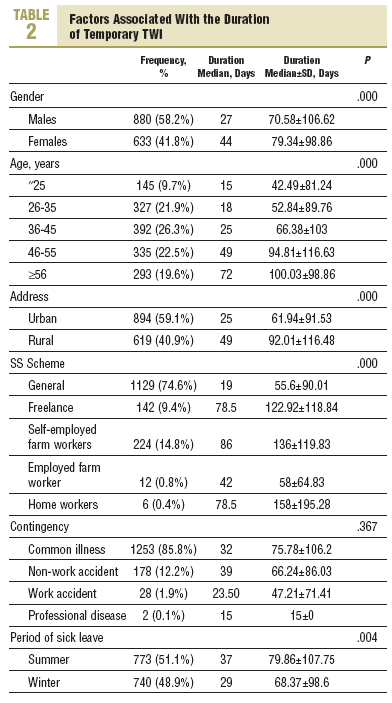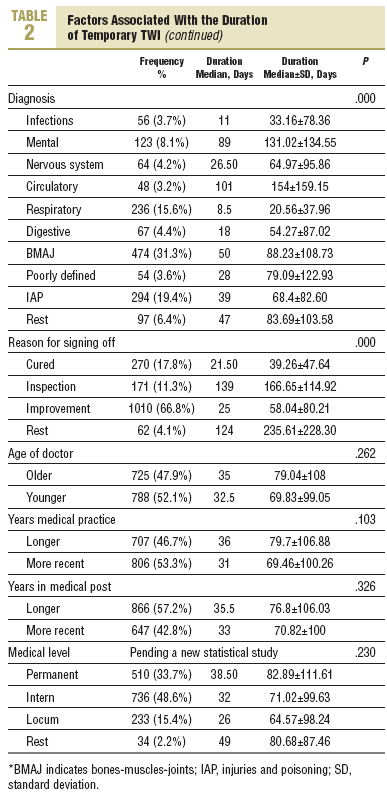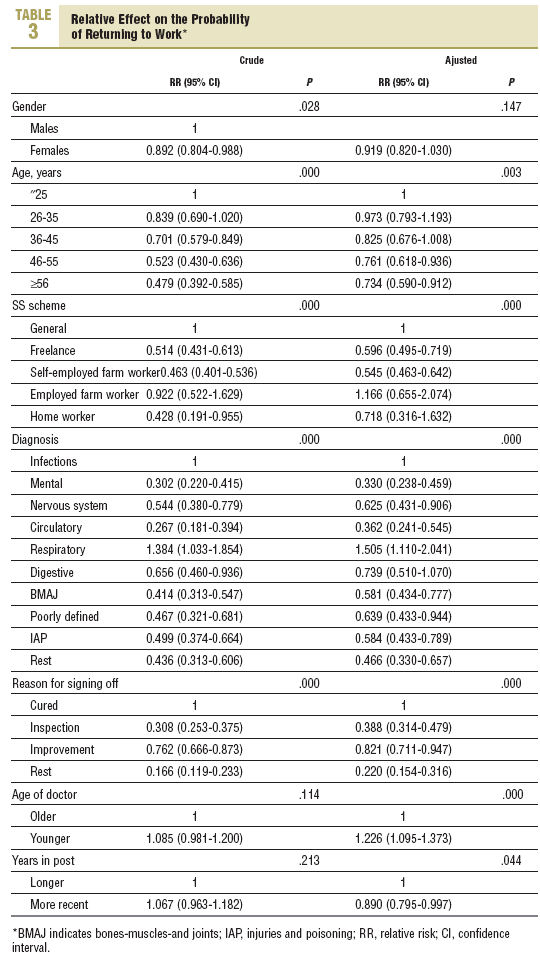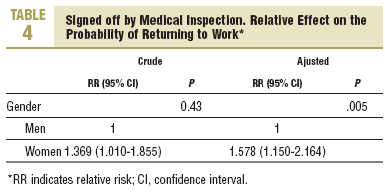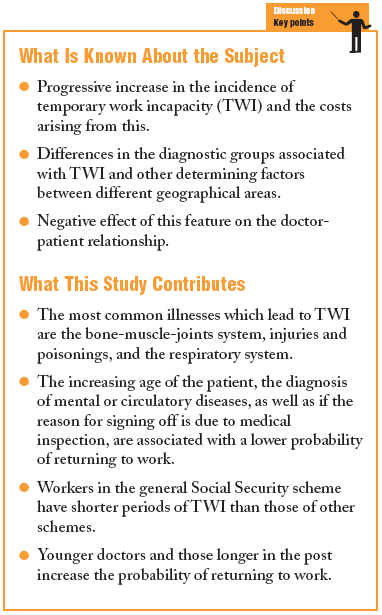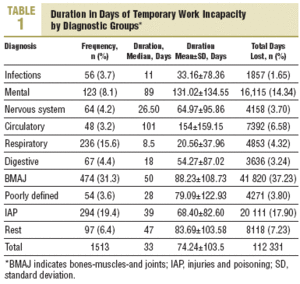Introduction
In the last few years there has been an increase in the number of people who have had to restrict their work activity due to an illness, and 1 in every 5 adults declare a limitation due to this cause for longer than 10 days.1 Between 1988 and 1994, the cost increased by more 10% per year.2 On auditing health spending of a health centre, half corresponded to temporary work incapacity (TWI), which almost doubles the drug spending and triples the spending on salaries.2,3
Despite the high level of this part of the spending, hardly anything has been done about it, if we compare it with other processes, such as drug spending or hospital admittances, over which measures are continually being put in place to rationalise them.4
In a recent publication, the Spanish Society of General Medicine analysed the problem of TWI and it establishes 2 large groups of causes which increase the risk of presenting with this: on the one hand, aspects derived from the characteristics of the worker, and on the other, factors depending on the health structure.5 As regards the diagnosis groups which are the reasons for TWI, there are differences between the different authors1,6-8
But this provision also makes the doctor-patient relationship difficult and challenges the principle of justice and benefit, knowing that ethically it must outweigh the first due to its social aspect of safeguarding the common good, on the second, with a more individual effect.4,9
TWI is defined as the temporary or permanent impossibility to carry out work, totally or partially.
In this situation there is insurance owing to an illness, common or professional, or due to accident, whether it is from work or not.10
The objective of this study is to find out the factors associated with the incidence and duration of TWI in the Galicia health area.
Participants and Methods
The study population belongs to the Monforte de Lemos health area (south of Lugo province), which has a total of 56 623 inhabitants, distributed in 11 predominantly rural municipalities, with 3 semi-urban centres. They belong to the active population group, which is composed of individuals affiliated to the Social Security, active, that is contributing, or in similar active situations, such as unemployed with the right to receive benefits. A random selection of 1513 processes was selected from the total record, a seventh of all the episodes.
A descriptive and retrospective study was carried out on a 3 year period, from the 1st June 2000 until 30th of May 2003. Information on the characteristics of the patient and the prescribing doctor was obtained from the TWI data base of the health area of the study. The information collected on the patient was; date of birth, gender, home address, the cause which led to the work incapacity code according to the ICD-9 with 3 digits, the reason for signing off, the eventuality, the month and the year of prescribing TWI, the duration of the TWI, the total processes of TWI during the period analysed, the SS scheme to which the patient is affiliated. The 17 diagnostic groups of the ICD-9 with 3 digits, were reduced to 10 for the analysis, and the 9 most frequent, and the remainder, given their low incidence, were grouped into a single category. The date of prescribing the TWI was classified into 2 groups, one for summer, between April and September, another for winter between October and March.
The age, gender, specialised training, years in practice, time in the post, work category, and type of medical contract were evaluated in the prescribing doctor. For the analysis of the age of the doctors, they were classified into 2 groups, those older than the median value of the distribution and those younger than this value. As regards the years in practice and time in the post, these were also analysed in 2 groups depending on the median of each distribution, as in the age variable.
The means and the frequencies were calculated according to the variable type considered. A comparison of the means was also performed using variance analysis and the Kruskal-Wallis test.
The relative effect of each variable on the probability of returning to work was estimated using Cox regression models.
Results
A total of 1513 episodes of TWI have been collected, with a mean duration of 74 days, and a total of 112 331 lost days (Table 1).
The most frequent illnesses were, bone, muscle and joints (BMAJ), injuries and poisonings (IAP), and respiratory diseases (RD) (Table 1).
As regards the lost days, the BMAJ illnesses and IAP continued to be the main causes, although followed, in this case, by mental problems (Table 1).
The duration of the TWI was significantly associated with the gender of the patient, the age, the address, the SS scheme, the time of year, the diagnosis, and the reason for signing off.
Thus, a longer duration was found in women, in the older age group, and in subjects with rural addresses, SS contributors as freelance, self-employed farm workers or home workers, during the summer period, and in the diagnosis of mental and circulatory system diseases.
No relationship was seen in our results between the duration of sick leave and the characteristics of the doctors analysed, such as age, years in practice, years in the same post or the permanency of this (Table 2).
On studying the relative effect of different variables on the probability of returning to work, it was observed that the influence of age, the SS scheme, the diagnosis and the reason for signing off, was significant. On the other hand, the gender of the patient did not have any significant effect on this analysis. The probability of returning to work is reduced with the increase in age. As regards the SS scheme, the freelancers, self-employed farm workers and home workers had a lower probability of returning to work than those of a general scheme.
As regards the diagnosis, the mental and circulatory system diseases were associated with a lower probability of returning to work, whilst those diagnosed with respiratory diseases had a higher probability of starting work again.
The TWI processes finalised by being signed off by a medical inspection were associated with a lower probability of returning to work than those signed off by being cured or by improvement (Table 3).
On studying the effect of each adjusted variable, we see that some of the characteristics of the doctor show their influence on the duration of the TWI. Thus, the fact of being a younger doctor, or longer in the post, increases the probability of returning to work (Table 3).
On analysing the correlation of the possible causes of signing off, curing, inspection and basically improving, some differential characteristics were observed between the signing off by inspection and the other causes. The older patients, with rural addresses, female gender, self-employed farm worker, with a diagnosis of BMAJ illness and the summer period appear to be associated with a more frequent intervention by medical inspection in the process of ending the TWI (data not shown). For this reason we studied this group of patients separately. In this case, the only variable which demonstrated a significant relative effect, in the crude and adjusted analysis, on the probability of returning to work is gender, this being increased in women (Table 4).
Discussion
The illnesses which most frequently cause TWI are, in order, those of the BMAJ, IAP, and RD.
The majority of authors observed that these 3 diagnosis groups cause the greater part of TWI episodes, although cardiovascular, neoplastic, psychiatric, digestive system, and neurological diseases are presented as the most frequent in other studies.6-16 With regard to the results of the national survey on health (NSH) of 1997, the lower influence of circulatory diseases merits mention, which was 3% in our sample as opposed to 9% in the NSH.1
The work days lost depended on the frequency, as well as the duration of the TWI episodes. The 3 diagnosis groups with a higher number of days lost are those of the BMAJ, IAP, and mental illnesses, and these three make up 65% of the total days lost. These results are similar to those observed in populations such as Cubans, where BMAJ illness is the main cause of TWI, followed by mental disorders and, in third place, the digestive system.13
In our geographical area, the mean duration of TWI episodes was 74 days, and the longest duration was for circulatory and mental illnesses. Other factors associated with a longer TWI have been, female gender, to be older, rural address, and the summer period. As regards the SS scheme, the episodes are longer for freelancers, farm workers and home workers. This could be due to the fact of not receiving benefit in TWI for short duration, therefore patients of this scheme may not apply for TWI benefit as they are anticipating starting work sooner. Other authors also refer to longer durations in freelance and farm worker schemes.6-18 The mean duration is longer than that observed in other studies in our country and varies between 44.5 and 62.7 days, despite the age distribution and diagnostic groups being similar.11,15,16,18
On analysing the relative effects of the different variables available on the probability of returning to work, it is reduced with the increase in age, in the freelancer, self-employed farm worker, and home worker schemes, with the diagnosis of mental, circulation system illnesses, BMAJ, and IAP. On the other hand, the diagnosis of RD has a higher probability of returning to work. Different authors agree in the association between increasing age and a reduction in the probability of returning to work.17,19-22 Other authors did not find a significant relationship between the probability of returning to work and age of the patient.23
As regards gender, some studies observe that women have shorter periods of TWI,23 others longer,24 and in other cases gender has no influence on the probability of returning to work.18,19 In our population no significant effect of gender on the probability of returning to work was observed, despite the shorter episodes of TWI in males.
The freelance and farm workers schemes are also mentioned in the literature as predictors of longer sick leave.17,18
Royo Bardono, as regards diagnosis groups, also obtained a higher probability of returning to work in RD and infections, and a lower probability of returning to work in psychiatric disturbances.18
Other factors not analysed in our health area have had an influence on the probability of returning to work, although in different socio-health situations, such as marital status,
number of children, length of employment, and socioeconomic level.18,19,23,25-27
In a recent publication, the results of a program of controlling TWI by means of improved collaboration between medical inspection and primary care has been presented, where a significant reduction in the number of sick leaves is achieved, without changing the duration.28 In our study, the TWI processes finalised by being signed off by medical inspection is associated with a lower probability of returning to work than those signed off by being cured or improving.
In this case, gender is the only variable which demonstrates a significant effect, in the crude and adjusted analysis, on the length of the TWI, and a return to work is more probable in women.
Acknowledgements
To Dr F. Fernández Álvarez, Medical Inspector, for his help in the collection of data and technical assessment.







